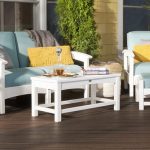Trex Composite Decking
There aren’t many things better than a well-built, reliable deck that offers plenty of space for relaxing and enjoying your days off. And, as we’ve talked about before, there is a wide range of customization options to suit your home, no matter your budget or layout.
This goes beyond just how the deck is designed, though. It also involves how it is built and the materials used. If you want to get a great end result that has it all – style, protection, aesthetics, and appeal – you really can’t go wrong with one of the top names in the composite materials industry: Trex, the masters of composite decking.

from ConsumerAffairs.com
Founded in 1996, Trex sets itself apart with eco-friendly, durable, and innovative flagship products that are designed to outperform wood on outdoor surfaces. Now expanded into 40 countries, with more than $740 million in sales each year, they’re defined by the cutting edge of deck improvements they have pioneered, from rot and splinter prevention to long-lasting colours and grains.

From Home Depot
These products start with the composite decking they’re known for – Transcend, Enhance, and Select lines of boards and materials – and branch out in additional areas like Spiral Stairs, Signature railing, and aluminum gates. For water management, they offer Elevations and RainEscape framing and drainage, and consumers looking for a cohesive look can choose from pergolas, outdoor furniture, outdoor kitchens, and special lighting. Homeowners can also build Trex fencing, lattices, cladding, and fire and water tables. For those who want it all, Trex can keep up in every department.
What is the difference between Trex and composite decking?
Composite decking is made up of layers of plastics, fibres, and other compressed materials, shaped and hardened into sheets and boards. While many companies make composite decking, none do it the way that Trex does: taking recycled plastics and other wood “waste products” that would likely end up in a landfill, and repurposing them into the strong and reliable pieces you see on decks all over North America. The company saves about 400 million pounds of plastic and wood from landfills every year.
Is Trex decking better than wood?
While this is always a tricky question, because different people have different preferences, there are many ways that Trex decking has been designed to improve on basic wooden boards. It is much easier to clean and maintain, needing no seasonal sealing, painting, or staining, and it does not react as strongly to extreme weather as wood does. Since it is not comprised of pure wood, it also resists termites and other insect infestations far better, and resists warping and rot more thoroughly.
Is Trex decking slippery?
Composite decking is not particularly different from regular wood in terms of being slippery – but with that said, any material will pose a hazard when there is water, ice, or loose debris like dirt on it. Some people have solved this problem by putting an enamel sealant on the walking surface that has been mixed with a grit to provide grip, but you can also ensure that there is no standing water or ice formation on high-traffic areas. In general, this isn’t an issue for the vast majority of people.
How long will a Trex deck last?
This will vary depending on a lot of factors – installation, environment, climate, frequency of use, and so on – but overall, Trex can be counted on to last for decades. The company has a 25-year warranty on almost every product!
Can I install Trex myself?
If you’re feeling handy one weekend, you can absolutely install any of their products yourself – their site is full of comprehensive user and installation guides that will get you through basically any process for their entire product catalogue. If you’re doing a small project, like replacing some railings or installing simple decklights, this could be a great way to work on a small budget. However, if you’re aiming to rebuild an entire deck that’s 100+ sq. ft. and you’re not sure where to begin, it’s probably best to consult with a pro.
How much does a Trex deck cost?
As mentioned on their own FAQ section, Trex decking typically costs between $9-$16 per square foot, depending on exact materials, measurements, and installation, as well as location and the amount being purchased in one transaction. To factor in labour, materials, and size, use their cost calculator for a reasonable estimate.
Are Trex decks worth it?
If you’re asking for our professional opinion – absolutely! We work with a lot of different styles and materials in this business, and Trex is one of our favourites. Not just because of the quality of their products, but because the whole consumer experience is considered, from start to finish.
If you’re interested in seeing for yourself, you can go to their website and get an estimate, choose your colour, and even order samples so you can get a real, tangible sense of what you’re buying before you commit. Try it in different lights and against different backdrops. Take your time and make an informed decision.
They also have “Find a Retailer” and “Find a Builder” functions for executing the actual work – but luckily, we’ve got that covered already for anyone wanting to build a deck in Calgary and the surrounding area. We’ve been working with their products for years, and we’re very familiar with how to make it look and perform its best…all you have to do is give Maritime West Construction a call and we’ll get going on your composite deck build in Calgary!





